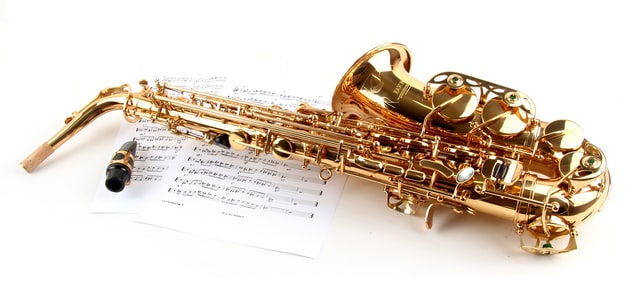Is saxophone hard to learn?


The saxophone is one of the easiest instruments to learn because:

The saxophone has so many keys on, it often makes beginners think that it’s actually a really complicated instrument but in fact having this many keys can be a big advantage. These keys are deliberately placed apart to match the curvatures of the human hand. The instrument is made taking human anatomy in mind and thus is quite ergonomic and comfortable to hold.

A leather pad under each key might not seem very remarkable when you first see the instrument, However if you compare saxophone to the clarinet which is one of the closest in its built, you can see a significant difference.
Clarinet needs a very good precision in placing your fingers to make a perfect seal in order to produce the accurate tones.
Even if you’re a millimetre away from the right spot, you will be hearing noticeable differences in the sound. The placement of fingers could be a challenge when beginning to learn the instrument.
On the other hand the leather pads on saxophone create this seal for you and by pressing the keys so there is much less accuracy in the way you place the fingers and it far easier to start playing the right notes early in the learning process.

Another great asset of the saxophone which makes it incredibly easy to learn it called the octave key.
This especially comes in handy in earlier stages of learning the instrument.
This little key is placed on the back of the sax body and you hit it with the left hand thumb.
What it does is it takes whatever fingering we’re playing in the lower register and it brings that note up by a whole octave, so we go from low to high just by pressing one little button.
This means that you don’t have to go back and relearn a bunch of fingerings for the upper register but just press that one button.
Producing a sound on the saxophone is less physically demanding than other woodwind instruments.
Usually, people sometimes confusingly refer to the saxophone as a brass family instrument, while it works with a completely different mechanism than a trumpet or a trombone.
While playing a brass instrument, a musician has to create a buzz with their mouth and blow into it to create a sound that makes it more physically demanding.
While playing saxophone, you use a reed attached to the mouthpiece that creates the buzz for you while blowing into the instrument.
Having the reed helps the saxophone be a lot less physically demanding than the trumpet or trombone.

Time it takes to learn a saxophone depends on multiple things:
A background in music can be a great help in learning any instrument.
The ability to read music can accelerate the learning process.
Making progress fast gives motivation and creates a snowball effect that can lead to great results.
Having experience playing other woodwind instruments can be a tremendous asset.
Woodwinds operate in a similar fashion, and switching from one to another can save you much time.
Playing any non-woodwind instrument can also be a time saver.
Knowing melodies, various turns, or solos can accelerate your learning and help you play much faster.
The amount of time you allocate to practice is the most important part when learning any instrument.
Practicing 4-6 hours a day with the right background can get you decent results even in 6 months while practicing 30 minutes a week might take you a few years or even more to play a simple tune.
Having a final goal in mind can determine the amount of time you’ll need to get there.
Being a professional might take you more than just to be able to play a few songs in front of your friends.

It’s important which saxophone you’re starting your sax journey with.
The most popular beginner saxophone is an alto sax mostly because of its tonal range and classic style, however, some also start on tenor sax which might be slightly more demanding physically but still a great place to start while being a beginner.
Learning with a professional instructor can make a big difference. Doing it correctly yourself will be more time-consuming.
To do that, you have to do much research during the study process, which takes time, while there is a risk of learning something in the wrong way, needing to re-learn afterward.
With a professional tutor, you know you play the instrument correctly from the beginning, which is a game-changer if you want to learn it quickly.

Yes, you can learn saxophone yourself. There are plenty of lessons online that can help you and instruct you to be a saxophonist and it’s feasible.
If you’re determined to learn it and acknowledge the fact that you’ll have to sacrifice many hours to practice, your goal will be achieved. Many YouTube channels can help you through.
If you have experience with playing instruments, it’s doable, but as mentioned above, it takes a lot of practice and dedication.
However, regardless of being able to access many online tutorials and paving your way through it, without a helping hand, it might be more difficult and time-consuming.
You will still need at least a few lessons with a professional to get started the right way, with the posture, hand alignment, and breathing technique.
Getting these basics right at the beginning might be way easier and less risky with few classes in a starting phase.
Check out this video from beginner series of BetterSax channel which seems to be covering the all the basics you need to know if you decide to do it completely on your own:
It is always tempting to buy an instrument that is most affordable, however try to avoid this with the saxophone.
Buying a cheap instrument in this case will affect the whole learning process and you will end up having a pretty bad experience.
Try to buy an affordable but a decent quality instrument from a brand name that is reputable.
For example try brands like Yamaha, which are known for producing decent beginner saxophones.

Experience
Finding a good and knowledgeable saxophone teacher will make the whole process way easier.
A good instructor will be able to help you avoid many bad habits, and the overall learning process will be quite fast and you’ll be able to sharpen your playing skills much faster.
Matching Style
Try finding an instructor that has a deep understanding of the instrument and few years of experience playing behind the back.
It is also important not to realise that some instructors might have the inclination towards a specific genre of music thus might influence your style in the beginning.
Knowing this, you need to choose the instructor that matches your musical preference.
Avoid Multi-instrumentalists
Another important detail while choosing the instructor is to choose a person whose primary instrument is the saxophone.
There are many instrument professionals that are actually multi-instrumentalists.
These musicians have enough skills to play the instrument on a professional level but might fall back when comparing their skills to the uni-instrumentalist that spend most of the time with one instrument.
Concentration is the key here. Remember not to get obsessed with one small thing that you can’t do the way you want it.
Consider that if you practice at least 30 minutes every day, will bring you better results than practicing 5-7 hours once a week.
In case you’re traveling and are unable to practice the sax, you can still work on breathing exercises.
Additionally, you can try tongue articulation by repeating.
Regular short sessions, when your mind is concentrated on playing the saxophone, are always better than a long one when you’re not focused.
Don’t put pressure on yourself, take short breaks during the session to fresh up your mind.

For an amateur person, who’s eager to learn how to play the saxophone, a classic member of the sax family – the alto would be a great start.
Alto saxophone is more convenient, compact, and easy to handle. It is a perfect match for beginners.
Along with the size and weight, the mouthpiece, spacing between the keys makes it simple and trouble-free to start learning.
If you have a look at the music books, the majority of them are written for Alto.
Tenor sax is also a very popular choice for people who’re just starting playing. Tenor sax offers a deeper and fuller sound, whilst Alto has a more highly-pitched sound.
Both of them are played in the same manner.
If you blow through the mouthpiece and press different combinations of keys, you will enjoy at least two and a half octaves.
Tenor saxophone has been used by people such as John Coltrane, Dave Liebman, Lester Young.
Charlie Parker, Phil Woods, and David Sanborn played on an Alto.
| Cookie | Duration | Description |
|---|---|---|
| cookielawinfo-checkbox-analytics | 11 months | This cookie is set by GDPR Cookie Consent plugin. The cookie is used to store the user consent for the cookies in the category "Analytics". |
| cookielawinfo-checkbox-functional | 11 months | The cookie is set by GDPR cookie consent to record the user consent for the cookies in the category "Functional". |
| cookielawinfo-checkbox-necessary | 11 months | This cookie is set by GDPR Cookie Consent plugin. The cookies is used to store the user consent for the cookies in the category "Necessary". |
| cookielawinfo-checkbox-others | 11 months | This cookie is set by GDPR Cookie Consent plugin. The cookie is used to store the user consent for the cookies in the category "Other. |
| cookielawinfo-checkbox-performance | 11 months | This cookie is set by GDPR Cookie Consent plugin. The cookie is used to store the user consent for the cookies in the category "Performance". |
| viewed_cookie_policy | 11 months | The cookie is set by the GDPR Cookie Consent plugin and is used to store whether or not user has consented to the use of cookies. It does not store any personal data. |
